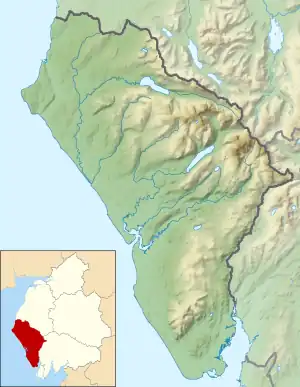| Hard Knott | |
|---|---|
 Hard Knott Location in the Lake District  Hard Knott Location in Copeland Borough | |
| Highest point | |
| Elevation | 549 m (1,801 ft) |
| Prominence | 154 m (505 ft) |
| Parent peak | Scafell Pike |
| Listing | Marilyn, Wainwright |
| Coordinates | 54°24′37″N 3°11′11″W / 54.41032°N 3.18634°W |
| Geography | |
| Location | Cumbria, England |
| Parent range | Lake District, Southern Fells |
| OS grid | NY231023 |
| Topo map | OS Landrangers 89, 90, Explorer OL6 |
Hard Knott is a fell in the English Lake District, at the head of Eskdale.
Geology
Rhyolitic lava-like tuff of the Bad Step Tuff forms the summit rocks with the dacitic lapilli-tuffs of the Lincomb Tarns Formation to the north west. Border end shows outcropping plagioclase-phyric andesite lavas of the Birker Fell Formation.[1]
Summit
Hard Knott reaches a height of 549 metres (1,801 ft), the summit knoll bearing a cairn. There are other named tops on the ridge in addition to the summit, with Yew Bank to the north and Border End to the south. Hard Knott is famous for its superb view of the Scafell massif to the north, while Harter Fell dominates the vista to the south. For a fabulous view of Eskdale it is recommended that the walker visits Border End half a mile to the south of the main summit.[2][3]
Ascents
The fell is usually climbed from the top of the Hardknott Pass where there are several parking spaces. It is also possible to begin the ascent from the foot of the pass in Eskdale, although this will triple the length of the walk and the height gained. However, the best plan is probably to climb Hard Knott in conjunction with the neighbouring fell of Harter Fell making a horseshoe walk starting and finishing in Eskdale. From the top of the pass it is a short ascent to the fell summit following an electric fence that skirts to the right of the dangerous looking Raven Crag and takes the walker to the summit in a short time. Other possible routes include a pathless ascent from the Esk via The Steeple, a circuitous walk via the head of Moasdale and an ascent of the eastern flanks via Dod Pike.[2]
References
- ↑ British Geological Survey: 1:50,000 series maps, England & Wales Sheet 38: BGS (1998)
- 1 2 Richards, Mark: Mid-Western Fells: Collins (2004): ISBN 0-00-711368-4
- ↑ Alfred Wainwright: A Pictorial Guide to the Lakeland Fells, Book 4: ISBN 0-7112-2457-9

